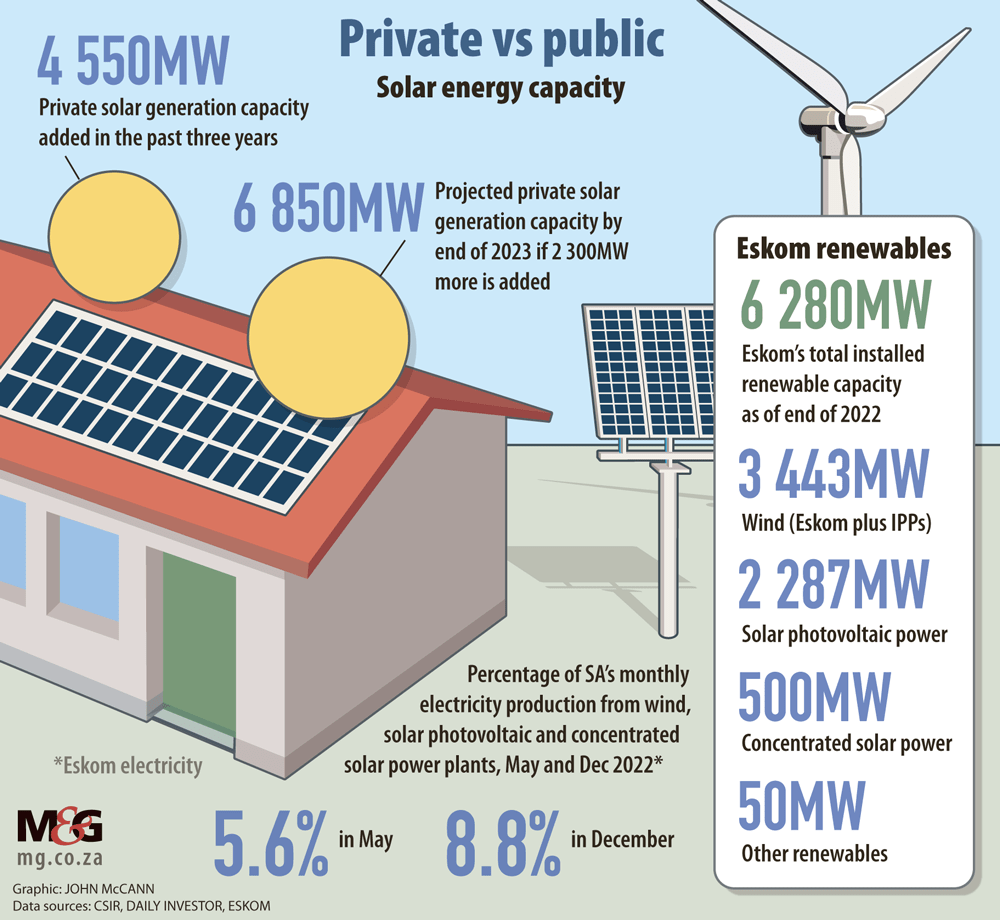More businesses are now using solar panels for energy. Photo: David Harrison
Eskom’s decrease in load-shedding can be attributed to more solar uptake from businesses and residential areas who have invested in renewable energy.
This is according to energy expert Chris Yelland, who said the sudden interest in solar photovoltaic and battery storage being placed in thousands of smaller and medium-sized installations across South Africa has led to the decreased demand for power from Eskom.
Last week, Electricity Minister Kgosientsho Ramokgopa said Eskom has had fewer breakdowns, lower planned maintenance and lower demand, which has seen a significant decrease in load-shedding.
Frustrated by load-shedding caused by Eskom and its impact on businesses, many electricity users migrated to alternative electricity sources like solar and wind. This has seen a major boom in the solar industry, making it the alternative to Eskom.
Eskom, which has enjoyed the benefits of being the sole provider of electricity in South Africa for 100 years, has however been unable to keep up with the electricity demand that the South Africa population demands.
Eskom said although there is an increase in solar uptake for households and businesses, it does not see less demand during peak hours, as the system is still under pressure during those hours.
But it does not help us when we need it the most
In a response to questions, the utility said because the demand is between 6am-9am and 6pm-9pm, the solar energy has not been very effective to demand because it is not available.
“The System Operator estimates that there are about 4 000 megawatts of “effective” rooftop PV installed in the country. This can be measured at a national level as demand offset from the grid.
“However, the morning peak period and the evening peak period are the highest demand periods of the day for electricity and these occur when there is little contribution from PV generation. In particular, the evening peak period falls after sunset and is not supported by PV generation,” it said.
According to a research study by Gmaven, a South African real estate software and data services company, South Africa’s commercial property industry has the potential to ease the country’s power crisis, with enough roof space to generate 4.7 gigawatts of electricity, a new study has found.
“Installing solar panels on two-thirds of commercial properties in those cities’ main nodes would cost as much as R55 billion rand, yet they could generate electricity that leads to R12.3 billion of savings each year,” Gmaven said.
 (Graphic: John McCann/M&G)
(Graphic: John McCann/M&G)
The more houses and businesses migrate to solar, they can sell the excess power they produce to Eskom through feed-in tariffs and receive cash back.
This will benefit Eskom who will be able to use the excess power to cover the shortage in megawatts on the grid.
But according to Ramokgopa, the grid constraints in the country means that the excess power received from households and businesses will go to waste, as the grid cannot accept it.
While presenting his energy action plan last year in July, President Cyril Ramaphosa cited rooftop solar as one of the solutions to a 15-year power crisis that has worsened to the extent that rotational blackouts have been imposed almost every day this year.
“South Africa has a great abundance of sun which we should use to generate electricity. There is significant potential for households and businesses to install rooftop solar and connect this power to the grid,” he said.
Enticed by incentives to feed excess power to the grid, many companies in Cape Town have moved to solar energy to be able to receive cash back for the excess power they produce from solar energy.
The incentives include raising the feed-in tariff for households and businesses selling power back to its grid by 10.15%.
“Businesses can claim as much as 125% in tax deductions on renewable energy projects. Households can claim back 25% in tax deductions on solar panels for the next year. The incentive for households is capped at R15 000,” Cape Town mayor Mayor Geordin Hill-Lewis said in his budget vote in March.
According to Yelland, solar photovoltaics on domestic and commercial installations have been progressively increasing every year, which is starting to make a difference.
“If you bring on 1 000 megawatts of rooftop solar PV, and that’s what’s happening over a period, that reduces one load-shedding stage,” he said.
Mandisa Nyathi is a climate reporting fellow, funded by the Open Society Foundation for South Africa.